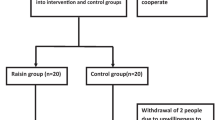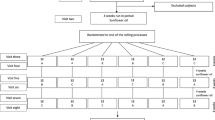Abstract
Astaxanthin, a carotenoid, has antioxidant activity as well as many positive effects, such as anticancer and anti-inflammatory effects. We performed a randomized, double-blind, placebo-controlled study to investigate the effects of astaxanthin on lipid profiles and oxidative stress in overweight and obese adults in Korea. In total, 27 subjects with body mass index >25.0 kg/m2 were enrolled and randomly assigned into two groups administered astaxanthin or placebo capsules for 12 weeks. Total cholesterol, triglycerides, high density lipoprotein (HDL) cholesterol, low density lipoprotein (LDL) cholesterol, apolipoprotein A1 (ApoA1), and apolipoprotein B (ApoB) were measured before and after intervention. Malondialdehyde (MDA), isoprostane (ISP), superoxide dismutase (SOD), and total antioxidant capacity (TAC), as oxidative stress biomarkers, were measured at baseline and at 4, 8, and 12 weeks after intervention. LDL cholesterol and ApoB were significantly lower after treatment with astaxanthin, compared with the start of administration, whereas none of the lipid profiles was changed in the placebo group. At the baseline, all four biomarkers were not significantly different between the two groups. Compared with the placebo group, MDA and ISP were significantly lower, but TAC was significantly higher in the astaxanthin group at 12 weeks. These results suggest that supplementary astaxanthin has positive effects by improving the LDL cholesterol, ApoB, and oxidative stress biomarkers.

Similar content being viewed by others
Abbreviations
- ApoA1:
-
Apolipoprotein A1
- ApoB:
-
Apolipoprotein B
- BMI:
-
Body mass index
- HDL:
-
High-density lipoprotein
- ISP:
-
Isoprostane
- LDL:
-
Low-density lipoprotein
- LPs:
-
Lipid profiles
- MDA:
-
Malondialdehyde
- OS:
-
Oxidative stress
- SD:
-
Standard deviation
- SOD:
-
Superoxide dismutase
- TAC:
-
Total antioxidant capacity
References
Remco F, Houshang M, Erik SG, John JP (2008) Obesity and dyslipidemia. Endocrinol Metab Clin N Am 37:623–633
Block G, Dietrich M, Norkus EP, Morrow JD, Hudes M, Caan B, Packer L (2002) Factors associated with oxidative stress in human populations. Am J Epidemiol 156:274–285
Melissas J, Malliaraki N, Papadakis JA, Taflampas P, Kampa M, Castanas E (2006) Plasma antioxidant capacity in morbidly obese patients before and after weight loss. Obes Surg 16:314–320
Ceriello A, Motz E (2004) Is oxidative stress the pathogenic mechanism underlying insulin resistance, diabetes, and cardiovascular disease? The common soil hypothesis revisited. Arterioscler Thromb Vasc Biol 24:816–823
Higuera-Ciapara I, Félix-Valenzuela L, Goyocoolea FM (2006) Astaxanthin: a review of its chemistry and applications. Crit Rev Food Sci Nutr 46:186–196
García-Malea MC, Acién FG, Del Río E, Fernández JM, Cerón MC, Guerrero MG, Molina-Grima E (2009) Production of astaxanthin by Haematococcus pluvialis: Taking the one-step system outdoors. Biotechnol Bioeng 102:651–657
Fassett RG, Healy H, Driver R, Robertson IK, Geraghty DP, Sharman JE, Coombes JS (2008) Astaxanthin vs placebo on arterial stiffness, oxidative stress and inflammation in renal transplant patients xanthin: A randomized controlled trial. BMC Nephrol 9:17
Karppi J, Rissanen TH, Nyyssönen K, Kaikkonen J, Olsson AG, Voutilainen S, Salonen JT (2007) Effects of astaxanthin supplementation on lipid peroxidation. Int J Vitam Nutr Res 77:3–11
Andersen LP, Holck S, Kupcinskas L, Kiudelis G, Jonaitis L, Janciauskas D, Permin H, Wadström T (2007) Gastric inflammatory markers and interleukins in patients with functional dyspepsia treated with astaxanthin. FEMS Immunol Med Microbiol 50:244–248
Comhaire FH, El Garem Y, Mahmoud A, Eertmans F, Schoonjans F (2005) Combined conventional/antioxidant “Astaxanthin” treatment for male infertility: A double blind, randomized trial. Asian J Androl 7:257–262
Ikeuchi M, Koyama T, Takahashi J, Yazawa K (2007) Effects of astaxanthin in obese mice fed a high-fat diet. Biosci Biotechnol Biochem 71:893–899
Hussein G, Nakagawa T, Goto H, Shimada Y, Matsumoto K, Sankawa U, Watanabe H (2007) Astaxanthin ameliorates features of metabolic syndrome in SHR/NDmcr-cp. Life Sci 80:522–529
Hiroshi Y, Hidekatsu Y, Kumie I, Yoshiharu T, Takashi K, Hiroki T, Norio T (2010) Administration of natural astaxanthin increases serum HDL-cholesterol and adiponectin in subjects with mild hyperlipidemia. Atherosclerosis 209:520–523
Choi HD, Kim JH, Chang MJ, Kyu-Youn Y, Shin WG (2011) Effects of astaxanthin on oxidative stress in overweight and obese adults. Phytother Res [Epub ahead of print]
Yang Y, Seo JM, Nguyen A, Pham TX, Park HJ, Park Y, Kim B, Bruno RS, Lee J (2011) Astaxanthin-rich extract from the green alga Haematococcus pluvialis lowers plasma lipid concentrations and enhances antioxidant defense in apolipoprotein E knockout mice. J Nutr 141:1611–1617
McQueen MJ, Hawken S, Wang X, Ounpuu S, Sniderman A, Probstfield J, Steyn K, Sanderson JE, Hasani M, Volkova E, Kazmi K, Yusuf S, INTERHEART study investigators (2008) Lipids, lipoproteins, and apolipoproteins as risk markers of myocardial infarction in 52 countries (the INTERHEART study): A case-control study. Lancet 372:224–233
Michel F, Bonnefont-Rousselot D, Mas E, Drai J, Thérond P (2008) Biomarkers of lipid peroxidation: Analytical aspects. Ann Biol Clin 66:605–620
Morrow JD, Chen Y, Brame CJ, Yang J, Sanchez SC, Xu J, Zackert WE, Awad JA, Roberts LJ (1999) The isoprostanes: Unique prostaglandin-like products of free-radical-initiated lipid peroxidation. Drug Metab Rev 31:117–139
Bannister WH, Rotilio G (1987) Aspects of the structure, function, and applications of superoxide dismutase. CRC Crit Rev Biochem 22:111–180
Apak R, Güçlü K, Ozyürek M, Karademir SE, Altun M (2005) Total antioxidant capacity assay of human serum using copper(II)-neocuproine as chromogenic oxidant: The CUPRAC method. Free Radic Res 39:949–961
Sutherland WH, Manning PJ, Walker RJ, de Jong SA, Ryalls AR, Berry EA (2007) Vitamin E supplementation and plasma 8-isoprostane and adiponectin in overweight subjects. Obesity (Silver Spring) 15:386–391
Ozata M, Mergen M, Oktenli C, Aydin A, Sanisoglu SY, Bolu E, Yilmaz MI, Sayal A, Isimer A, Ozdemir IC (2003) Increased oxidative stress and hypozincemie in male obesity. Clin Biochem 35:627–631
Melissas J, Malliaraki N, Papadakis JA, Taflampas P, Kampa M, Castanas E (2006) Plasma antioxidant capacity in morbidly overweight patients before and after weight loss. Obes Surg 16:314–320
Miki W (1991) Biological functions and activities of animal carotenoids. Pure Appl Chem 63:141–146
Acknowledgments
This work was supported by a grant of the Korea Health 21 R&D project, Ministry of Health and Welfare, South Korea (A050376). The authors would like to thank all subjects participated in this study. No writing assistance was acquired for this paper. The contributions of the authors to the manuscript are as follows. H.C.: study design, data collection, samples analyses, data analyses and writing of the manuscripts; Y.Y.: study design and coordination; W.S.: study design, coordination and reviewing the manuscript. All authors read and approved the final manuscript.
Disclosure
The authors declared no conflict of interest.
Author information
Authors and Affiliations
Corresponding author
Rights and permissions
About this article
Cite this article
Choi, H.D., Youn, Y.K. & Shin, W.G. Positive Effects of Astaxanthin on Lipid Profiles and Oxidative Stress in Overweight Subjects. Plant Foods Hum Nutr 66, 363–369 (2011). https://doi.org/10.1007/s11130-011-0258-9
Published:
Issue Date:
DOI: https://doi.org/10.1007/s11130-011-0258-9




